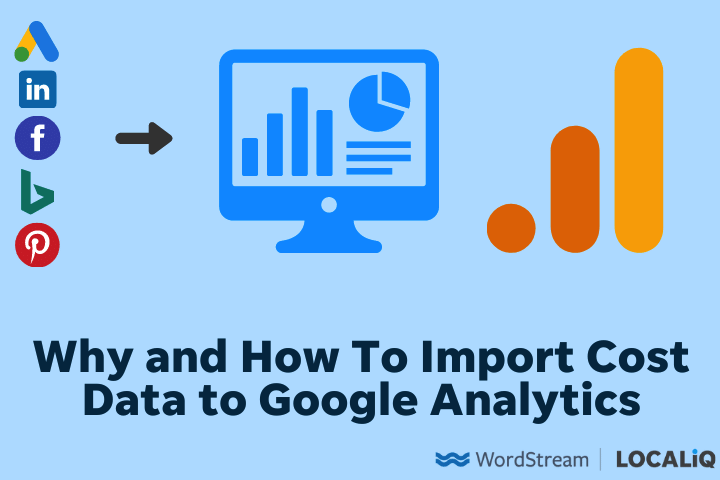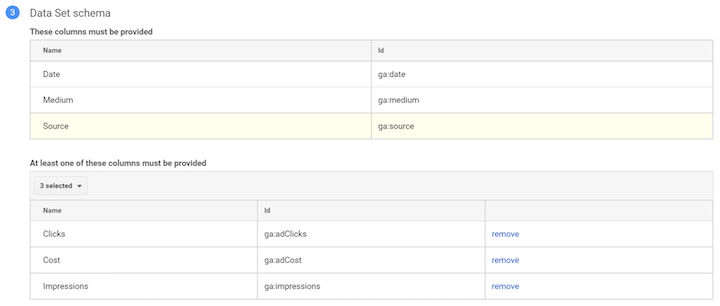How and Why to Import Cost Data to Google Analytics (+Template).
Clients have asked me several times how they can view cost information for non-Google channels within Google Analytics. Clients don't want to visit each paid media channel to view the data. Even if I create a Google Data Studio dashboard to compile all the data, some clients only use Google Analytics. What do I do?

I use a spreadsheet to import the cost data into Google Analytics. Although the process is quite manual, I'll admit that the manual method is the only one I know how to do it, it's easy and takes very little time.
Let's get started to make ROAS reporting in Google Analytics for all your paid channels much easier.
Why import cost data into Google Analytics
This reporting strategy saves you the time of going into every channel and reporting on ad performance individually. You can save time by having everything in one place and have a complete view of your overall PPC performance.
Cost data can be viewed such as:
- Cost
- CPC
- CTR
- ROAS
From channels such as:
- Bing
These resources can help you compare your performance with benchmarks
What information can be uploaded to Google Analytics?
Although it may seem silly, I am referring to more than cost information for each channel. This is because when we upload our spreadsheets, we must attribute the cost to a datapoint.
You cannot upload any other data to Google Analytics. There are a limited number of data sets. Let's take a look at them.
Information required
When uploading your information, there are three pieces you need to include. These are the three pieces of information you must include when uploading your information:
- Date
- Source
- Medium
Include one
While Cost is the obvious choice, you only need to include one of these:
- Cost
- Impressions
- Clicks
Information optional
You can include any of the following data when you upload your information. However, they are not required. Although there are many more options, some options in Google Analytics only pertain to Google Ads accounts. If you wish to add other paid media channels information, here are some data sets that you can use.
- Referral path
- Ad Content
- Campaign
- Final URL
- Keyword
- Search for a Query
How to create your CSV file for cost data import
When creating your spreadsheet (you can reference this sheet as an example), each of the data points mentioned in the previous section must be in their own column.
Here is an example of how I pull LinkedIn information from one of my clients (campaign name changed) for June 2021.

Column header format
When creating column headers, you can't simply add "Campaign" and "Medium." You have to ensure that your headers are properly formatted. Uploads that are not formatted correctly will be rejected.
Instead of using Date as your column header you should format it as ga.date. Instead of using Medium as your column header you should format it as ga.medium.
Formatting the date
Next is the Date. Your Date should be formatted as YYYYMMDD. Any other date variations will not be accepted. Your upload will be rejected. The format is YYYYMMDD. This means that any date information you pull must be at the day level.
Name the file
Last but not least, when you import campaign names, make sure that the file uploads names match any campaign names you may manually tag in your URLs. You could end up with duplicate campaigns in Google Analytics. The data may also be split between campaigns with different names.
You will see the schema ID when you go to Google Analytics and select your columns.

Once we have all this information, let's head to Google Analytics to upload the data.
How do I import cost data into Google Analytics
Select data import from property column
Go to your Admin section once you have logged into Google Analytics. Next, click on the link "Data Import" at the bottom of the Property column.

Import new data
Click the red button "Create". Next, choose Cost Data

Name your data set
You will be asked to name your data collection and choose the Google Analytics views to which it should be applied. Next, I will select the data set schema options I have shown in my spreadsheet example. You can see that the IDs match my column headers

Upload your CSV file
After saving the data set, you'll need to return to the Data Import page. Next, click on "Manage Uploads".

Then upload your CSV file. Since it has never caused me any problems, I have used the CSV MSDOS file type.
Once you have uploaded your file, you will receive a status notification indicating whether it was accepted (Completed), or rejected (Failed). To show you the potential problems, I uploaded my file several times with incorrect data.

Any mistakes should be corrected
Click on the Failed link if your upload status shows Failed. This will give you information about what to do to fix it. Here is an example of incorrect column headers.

It is easy to spot your mistakes and correct them.
Refresh when necessary
Once you have completed your upload, you're good to go. You can always refresh the data set if you have uploaded more dates than you intended. To delete or upload older files, you can always return to "Manage Uploads".
Google Analytics now displays your cost data
Go to Acquisition > Campaigns > Cost analysis to view your Google Analytics cost data.

Your data may take up to a few hours before it starts showing up in Google Analytics. You can now create a custom Google Analytics report to see cost data from other paid media channels.
How to personalize your cost analysis report
The above example shows that we can sort by Source/Medium. We can also see CTR, Cost, and CPC data. You can add another dimension to view campaign, ad content and keyword. You can also add metrics like ROAS, transactions and revenue to your site, as well as RPC (revenue-per-click), and many more.
Click Edit in the upper-right corner of your report to do this. You can adjust dimension drilldowns and add metrics.

Is it possible automate the import of cost data?
Yes. Many popular tools are available that automate the import of ad cost data daily.
These tools make it easy to save time and not have to manually export the ad costs data for each period.
Simply connect to your Google Analytics account and select the ad platforms that you use. The system will automatically import your daily ad costs data.
Examples of such tools (ours included!):
As I said, Data Studio also allows you to create dashboards with the same information.
Google Analytics allows you to see your ad performance across different networks.
You can see that there are several steps to be taken to get this information into Google Analytics. However, these tasks don't take too long.

Importing data can be a great way to make it easy for clients or you to view a range of information from your paid media channels all in one place.
Comments
Post a Comment